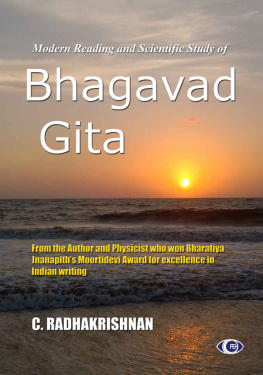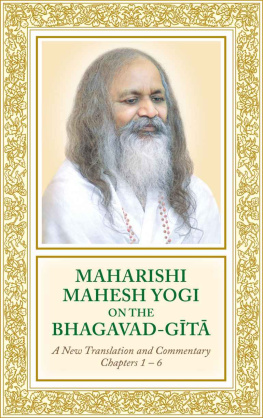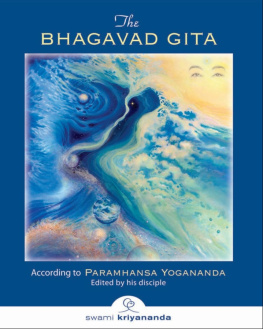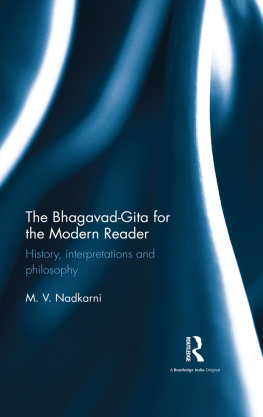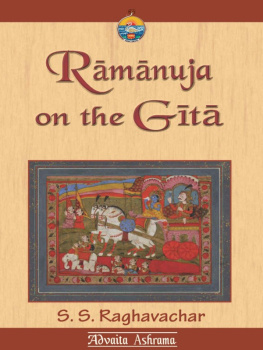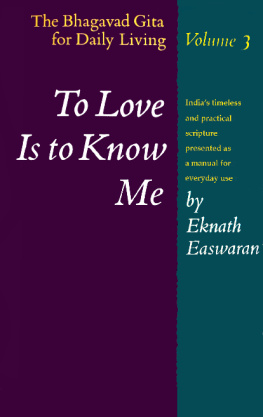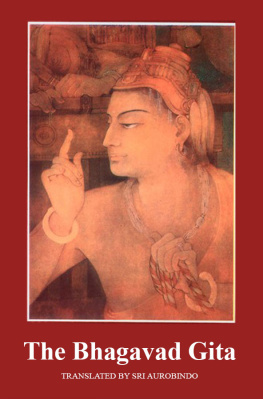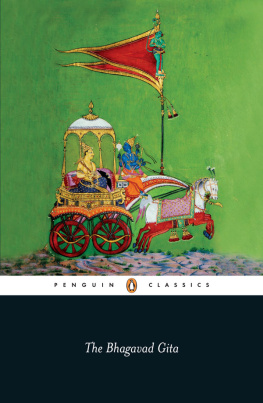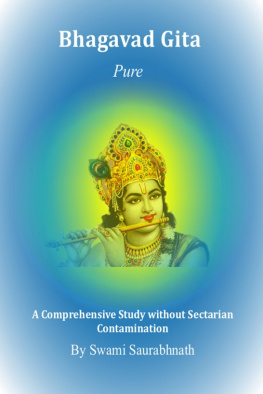BHAGAVAD GITA
Modern Reading and Scientific Study
by
C. Radhakrishnan
Second Edition

Published by Hi-Tech Books
Azad Road, Kaloor, Kochi 682017, India
Modern Reading and Scientific Study of the Bhagavad Gita, originally written in Malayalam, an Indian language, by C. Radhakrishnan and first published in that language in March 2011 under the title Gitadarsanam
Trans-created in English by C. Radhakrishnan and Gopal K. R.
Text editing and pre-production: Gopal K. R.
First published on October 2016
Publisher: Hi-Tech Books Kochi 682017
Second Edition October 2017
Copyright 2016 C. Radhakrishnan and Gopal K.R.
All rights reserved.
No part or aspect of this book, including interior design, cover design or any other part of its style of production, may be reproduced or transmitted in any form except with the permission of the authors.
About the author
C Radhakrishnan is an established author in the Malayalam language. A scientist-turned writer, he has contributed to all branches of creative literature besides popular science. He has been honoured by India's National Akademi of Letters, the Kerala Sahitya Akademi and almost every other body promoting creative literature of the language he writes. He is the winner of Ezhuthachan Award (the highest recognition given to authors in the Malayalam language), and also the Moortidevi Award of the Bharatiya Jnanapith Trust for the best creative work in Indian languages. A multi-faceted personality, he has worked as scientist, popular science journalist, film director, columnist, and editor of national and literary journals.
Born on 15 Feb 1939 in Chamravattom village in Kerala, C. Radhakrishnan became the Winner of Best Student Gold Medal at Achutha Varier High School, Ponnani, winner of Madras University Sharpe Scholarship - Inter: Zamorin's College, Calicut, and Winner of Top Rank Gold medal - Graduation: Physics, Zamorin's College, Calicut - l. PG: Post Graduation - Applied Physics; Research (Astrophysics). The author also won in every literary competition during his academic career. He translated Daniel Defoe (M. Flanders) and Lincoln Bernet ( The Universe and Doctor Einstein ) at age seventeen, and David O.Woodbury's Outward Bound for Space in 1962.
C. Radhakrishnan became scientific Assistant at Astrophysical Observatory, Kodaikanal in 1960 and became officer-in-Charge, World-Wide Seismology Centre, Pune in 1962. He helped launch and establish Science Today (Times of India), the first popular science magazine of India, at a young age of 24, and later held senior positions with national print media organs. He was also the science Editor of Link Magazine and Patriot Daily , Delhi, 1968-'72.
The author is a well known Vedantic scholar and has written numerous articles on the subject. He was the editor of Malayalam magazine Piravi published by the School of Bhagavad Gita . He has done an exhaustive work on the Bhagavad Gita titled Gitadarsanam which is very popular in Malayalam language. The present book Bhagavad Gita critically approaches yoga sastra in the light of modern science and, at the same time evaluates modern science vis--vis yoga sastra.
His research on problems fundamental to astrophysics gave rise to a monograph titled " Unity of Space-Matter Manifestations ", published as early as in January 1988. " Stuff and Style of the Universe ", a book which is a popular science elaboration of the monograph, was published Nov. 2002 by Hi-Tech Books. The first Scientist-President of India, Dr. A. P. J. Abdul Kalam, expressed appreciation of the work done, and the model attracted world attention. An article based on the book was also published in ' Science India ' (ISSN 0972-8287) in two issues, which came out on September 2012 and October 2012 (Vol. 15 No. 9 and Vol. 15 No. 10 respectively). Continued researches resulted in the book " The Secret Behind the Universe ", published July 2016, in which the original ideas were further refined and updated. A condensed version of the physics section of this book was published in January 2017 as an article titled " Avyakta: The Fabric of Space " in the Prespacetime Journal Vol 7 Issue 16 (Prespacetime Journal (ISSN: 2153-8301), QuantumDream Inc., P.O. Box 267, Stony Brook, NY 11790-0267, USA; is a physics journal which focuses on the origin, nature and mechanism of spacetime and its possible connection to a prespacetime; and models and experimental results on elemental particles, fundamental forces including gravity and related topics.) The entire article is available online to read or download from the journal website, and can be accessed through the authors site: http:://www.c-radhakrishnan.info
CONTENTS
PREFACE
Without Prejudices
There are two diagonally opposite view points on the Bhagavad Gita in relation to science. One rejects it as absolutely unscientific and superstitious whereas another claims that it has more knowledge than whatever modern science has discovered so far. This divergence extends to the evaluation of its utility. While some hold the Gita responsible for all setbacks and degeneration suffered by the Indian polity over thousands of years, many others believe that ultimate salvation can be achieved if one just keeps the Gita under the pillow and sleeps, without even opening it ever.
The Gita advises dependence upon science to achieve success in life. (Let science be your guide to distinguish between what matters and what does not 16.24). It is obvious that science here does not mean modern scientific knowledge only, because it is not the latters job to guide a person in emotional turmoil when faced with hard choices in his life. What is referred to here is adhyatma vidya , the science of ones true self. It is also known as par vidya . It makes use of ones own body, intuition, mind and intellect to find and access knowledge through oneself. On the other hand, modern science is apar vidya , the way to know and manipulate the external world. While the former is based on subjective and nontransferable experiences, the latter is built upon verifiable and impersonal results of objective experiments.
Modern science has been able to transform the material world dramatically. But fundamental questions are yet to be answered. For instance, what is life, why do bodies attract each other, how and where did the universe begin and to what end does it go on? Moreover, indiscretion in the application of scientific knowledge has caused untold miseries from plastic pollution to atomic bombs. In short, science and technology on its own have not been able to help human kind achieve sustainable peace and well being. Moreover, mans mind and environment have been getting dirtier almost proportional to the advancement of science, if not ahead of it. Mental unrest and tension multiply by geometric progression.
The emotional state of the observer, experimenter or applicator is no concern of modern science. Par vidya , on the other hand, in addition to seeking knowledge, presents the theory and practice of internal fulfillment. In fact, the knowledge it propounds cannot be imbibed unless ones mind is under control. Relying on superstition is not the answer. Rigid religious texts may not answer complex questions unless one learns for oneself how to work out answers and live accordingly. So the right combination of par vidya (true knowledge of oneself unbiased by superstition) and modern science can be considered a viable antidote to the ills of the world. Vedantic texts form the basis of the par knowledge. Therefore, the need of the hour is to closely examine Vedanta with a scientific approach and modern science in the light obtained from inferences from this. Both are products of human enquiry. Either oversimplified comparisons between the two or immature conclusions will not do. The reading of the Gita that follows is the result of a thoroughly critical attempt to find convergences and divergences between the two and to evolve an approach to life combining the two to the extent logically tenable.

